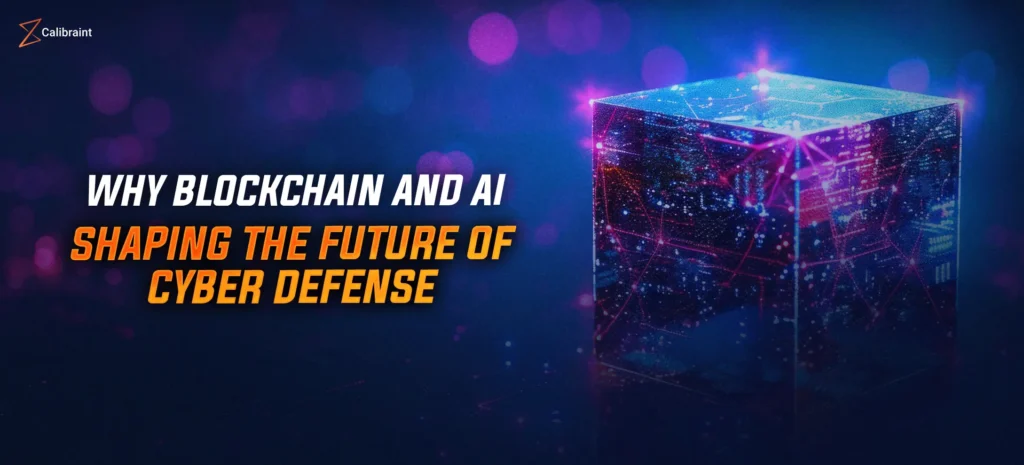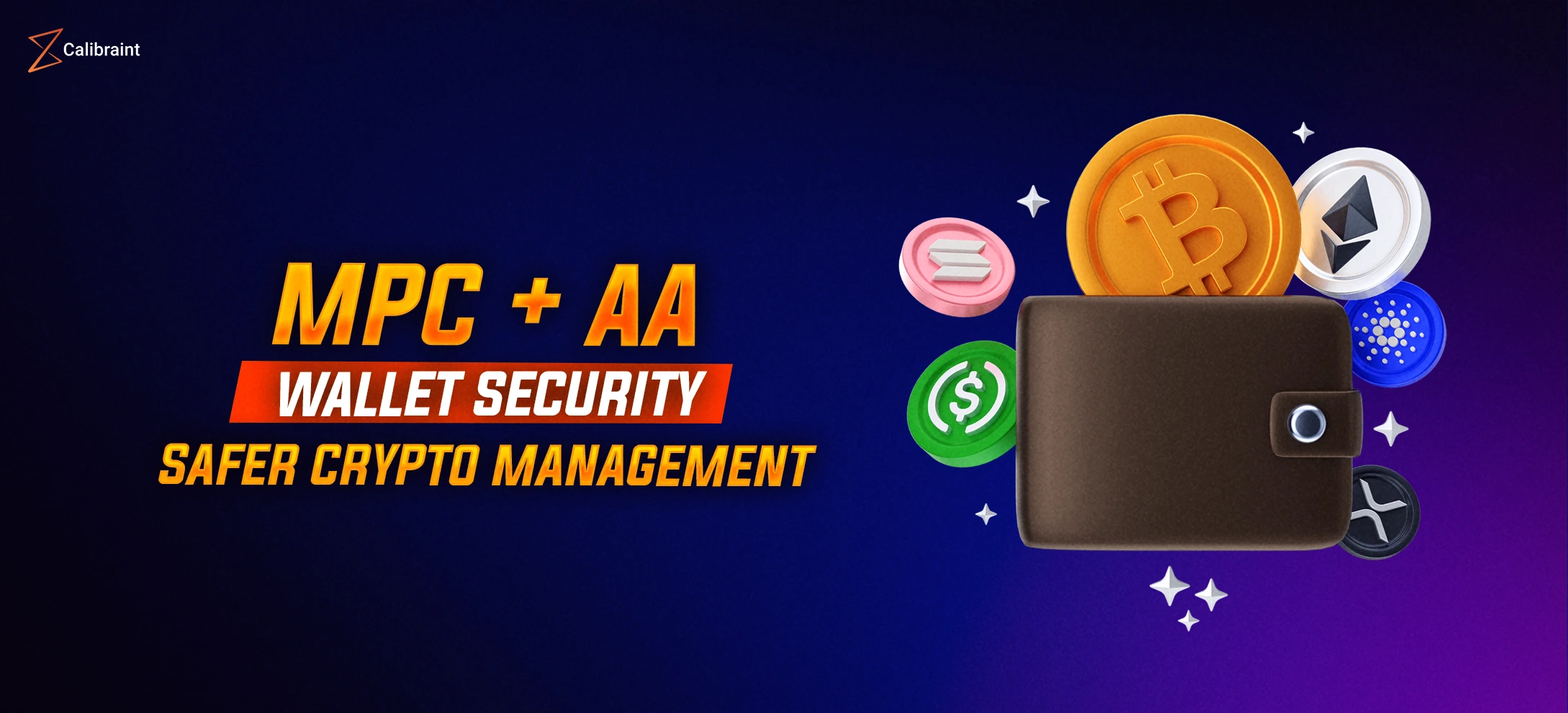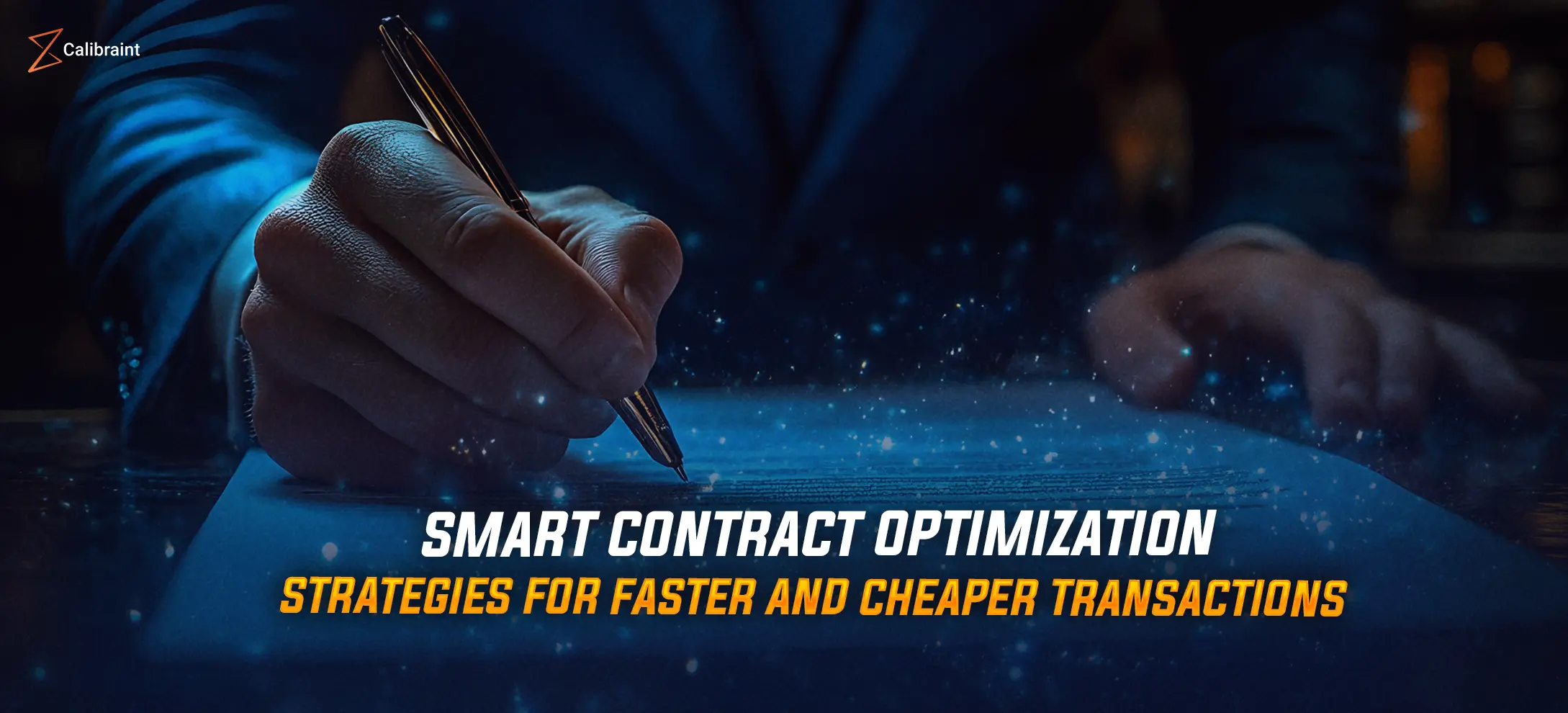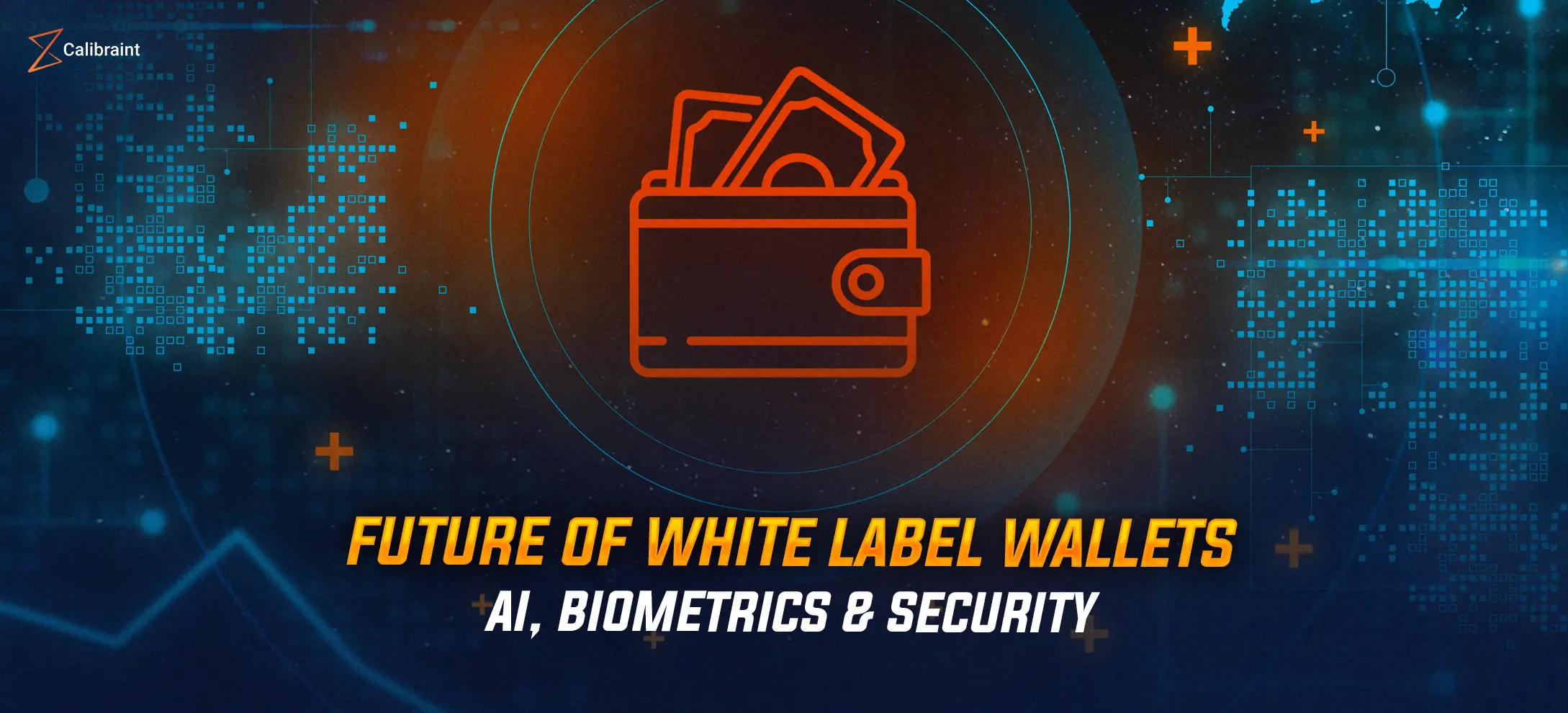Why Blockchain and AI in Data Security Are the Cornerstones of Modern Cyber Defense
Calibraint
Author
September 19, 2025

Global cybercrime damages reached $10.5 trillion in 2025, with enterprise attacks up 38% year over year. Traditional security architectures built for static perimeters and predictable threats crumble under the weight of sophisticated adversaries and exponentially expanding attack surfaces. The executive boardroom conversation has shifted from “if” to “when,” and the question becomes: what defense mechanisms can actually withstand tomorrow’s threats?
Blockchain and AI in data security do more than evolve current tools; they redefine how organizations protect, verify, and manage digital assets. Blockchain delivers cryptographic immutability and distributed trust. AI enables real-time threat detection and autonomous responses. Together, they form the backbone of enterprise security architectures designed for an era where digital transformation is the precondition for survival.
This blog examines how blockchain and AI in data security create a stronger foundation and what practical steps executives can take to build a robust cybersecurity strategy.
Why Legacy Security Models Are No Longer Enough
Legacy defenses were designed for a different era, one where enterprises operated within fixed boundaries and threats moved at a slower pace. Even though that time has passed, many organizations continue to operate under the same presumptions.
Perimeters No Longer Define Security
Perimeter-based security started breaking down as soon as enterprises shifted beyond static infrastructure. Cloud platforms, remote workforces, and interconnected systems dissolved the line between “inside” and “outside.” Yet many organizations still rely on perimeter-first models, using firewalls and signature detection as if attackers recognize those boundaries. This leaves security teams locked in a reactive cycle, addressing outdated threats while adversaries exploit the blind spots of a borderless enterprise.
Centralization Creates Fragile Systems
The weaknesses grow sharper with centralized security. Systems like Active Directory, certificate authorities, and monitoring platforms hold too much power in one place. A single compromise can put an entire enterprise at risk. If authentication hubs fail, access across the organization collapses. If monitoring platforms go offline, visibility vanishes at the very moment executives need certainty. What once seemed efficient becomes fragile when concentrated into single points of failure.
A Governance Challenge, Not Just Technology
Security is no longer confined to IT operations; it is a board-level priority that directly shapes enterprise trust and growth. Security is no longer confined to IT operations; it is a board-level priority that directly shapes enterprise trust and growth. Regulators, investors, and customers expect resilience, and legacy systems rarely deliver the assurance stakeholders require.
This creates an opportunity for executives to modernize governance by embracing architectures that reduce technical debt and increase confidence. Immutable audit trails strengthen compliance, while digital initiatives such as IoT adoption and data-driven services can be built on a secure foundation rather than defended after deployment.
If legacy defenses are collapsing under structural flaws, the logical question is: what technologies can establish trust and resilience at an enterprise scale? The answer begins with blockchain.
Blockchain’s Role in Data Security
Beyond traditional cybersecurity, blockchain technology fundamentally alters the way trust and integrity are integrated into an organization’s core functions.
- No Single Point of Failure: Traditional systems break when one server goes down or gets hacked. Blockchain spreads data across multiple computers, so there’s no single target for attackers. Even if several nodes fail, your data stays safe and accessible.
- Better Identity Management: Instead of relying on passwords that get stolen, blockchain uses cryptographic keys for authentication. Every access attempt creates a permanent record that can’t be changed later, which is perfect for meeting compliance requirements.
- Supply Chain Protection: Track every component from factory to deployment. Manufacturing companies can verify their IoT devices weren’t tampered with during shipping. Software teams can prove their code wasn’t altered between development and release.
- IoT Device Security: Internet of Things devices are notoriously vulnerable. Blockchain gives each device a unique, unbreakable identity and ensures firmware updates are legitimate. Devices can communicate securely without depending on central servers that hackers target.
- Trust Without Trusting: When working with partners or contractors, you don’t need to rely on blind trust. Blockchain provides cryptographic proof of actions and data integrity, making it safer to extend security across external parties.
AI’s Role in Data Security
1. Proactive Threat Detection
Modern security systems analyze massive volumes of network traffic and user behavior to spot threats before they cause damage. Instead of waiting for known attack signatures, these systems identify unusual patterns that signal new types of attacks. This shift from reactive to predictive security gives organizations critical time advantages.
2. Dynamic Security Baselines
Smart analytics create security profiles that automatically adjust to business changes. When new applications launch or employee roles shift, these systems learn normal operations within days instead of requiring months of manual configuration. This eliminates the false alerts that overwhelm traditional monitoring systems.
3. Instant Response Capabilities
Advanced threat detection compresses response times from hours to seconds. Systems can automatically isolate compromised devices, disable suspicious user accounts, and block malicious files before security teams receive notifications. This speed proves essential against threats that spread through networks in minutes.
4. Operational Efficiency
Organizations typically need dozens of security analysts to monitor and investigate alerts. Smart automation handles routine analysis independently, only escalating complex threats that require human expertise. This allows security teams to focus on strategic security improvements rather than constant alert management.
5. Long-Term Threat Recognition
Sophisticated attackers often spend months quietly moving through systems and stealing data. Advanced analytics identify these extended campaigns by correlating subtle indicators over time, patterns that human analysts miss due to information overload and time constraints.
The real breakthrough comes when these intelligent security systems combine with blockchain technology, creating a force multiplier effect that transforms enterprise defense.
Blockchain and AI Integration: A Force Multiplier
The convergence of blockchain and AI in data security creates something unprecedented: a self-defending, self-documenting security infrastructure that transforms how enterprises protect critical assets.
The Symbiotic Security Model
Machine learning algorithms excel at pattern recognition but struggle with data integrity. Blockchain ensures data immutability but lacks predictive capabilities. Together, they create a feedback loop where intelligent systems detect threats and blockchain networks provide tamper-proof verification of those findings.
When anomaly detection systems flag suspicious behavior, blockchain networks immediately create tamper-proof records of the incident and all response actions taken. This prevents attackers from covering their tracks while giving incident response teams confidence in their evidence chain.
Finance: Real-Time Fraud Prevention
Fraud detection systems often fail when attackers manipulate the monitoring tools themselves. By combining machine learning with blockchain, financial institutions create a safeguard against this weakness.
Machine learning flags suspicious transactions in real time, and blockchain locks those alerts into immutable records. Even if attackers infiltrate internal systems, they cannot erase or alter the evidence, giving banks a fraud defense that is both proactive and tamper-proof.
Healthcare: Patient Data That Stays Private
Hospitals and research groups are using blockchain with smart contracts to secure sensitive data. Every access to patient records is logged immutably, while analytics can still run on encrypted data. This keeps privacy intact while proving compliance with regulations like HIPAA.
The Business Case: Compliance Without Extra Cost
Enterprises that use blockchain audit trails report faster investigations, fewer false alarms, and easier compliance. Immutable records reduce manual paperwork and give regulators, partners, and customers independent proof that security systems work.
Phase 1: Foundation Assessment
Begin with security audits that expose vulnerabilities and establish baseline metrics. This assessment identifies where blockchain and AI in data security can close gaps while clarifying which systems are ready for integration and which require modernization. The outcome: a clear map of priorities tied to measurable business risks.
Phase 2: Targeted Proof-of-Concepts
Deploy limited-scope pilots in high-impact areas where results can be measured quickly. Internet of Things environments offer ideal testing grounds because they generate massive data volumes that traditional security tools struggle to monitor effectively. By applying blockchain verification and intelligent monitoring to focused use cases, organizations demonstrate value without disrupting core operations
Proof-of-concept projects should target specific use cases: device authentication in manufacturing environments, transaction verification in financial processing, or patient data integrity in healthcare systems. Success in these bounded environments builds organizational confidence and technical expertise.
Phase 3: Strategic Integration
Scale successful pilots into enterprise-wide implementations that align with broader digital transformation objectives. This phase requires integration with existing security operations centers and compliance frameworks.
A robust cybersecurity strategy at enterprise scale demands coordination across multiple technology domains. The combination of blockchain verification and intelligent threat detection becomes part of a comprehensive defense architecture rather than standalone solutions.
Learn more about implementing conversational AI in finance to complement your security transformation.
The Future of Cybersecurity Leadership
Enterprises can no longer rely on legacy defenses that crack under scale and complexity. Blockchain and AI in data security deliver a foundation where risk management strengthens with growth, compliance transforms into a competitive edge, and trust becomes verifiable.
If you’re ready to move beyond reactive security, Calibraint gives you the strategic expertise to align protection with business growth. With dedicated blockchain development services, you can implement solutions that protect critical data, speed up compliance, build customer trust, and create new revenue streams.
Calibraint
Author
September 19, 2025



























